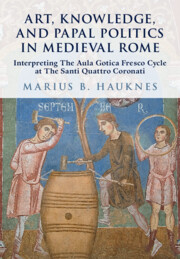 Art, Knowledge, and Papal Politics in Medieval Rome
Art, Knowledge, and Papal Politics in Medieval Rome The Virtues and Vices at Santi Quattro Coronati
Published online by Cambridge University Press: 30 January 2025
The allegorical cycle of Santi Quattro Coronati’s north bay is dominated by ten triumphant virtues arranged on the same register as the calendar in the opposite bay. Each personified virtue carries a saint on its shoulder while trampling two smaller figures. The small-scale vanquished figures represent each virtue’s corresponding vice and a historical character who exemplifies it. The saints and the trampled villains serve as historically real exempla of the moral qualities represented by the personified virtues and vices. Inscriptions identify all figures, several of which display scrolls with textual citations drawn from scripture, proverb collections, and classical poetry. The representation of virtues as female knights combating vices conforms to a visual tradition that can be traced back to the ninth-century manuscript illustrations of Prudentius’s Psychomachia. The Quattro Coronati frescoes, however, bring the conventional motif to new levels of pictorial complexity.
To save this book to your Kindle, first ensure [email protected] is added to your Approved Personal Document E-mail List under your Personal Document Settings on the Manage Your Content and Devices page of your Amazon account. Then enter the ‘name’ part of your Kindle email address below. Find out more about saving to your Kindle.
Note you can select to save to either the @free.kindle.com or @kindle.com variations. ‘@free.kindle.com’ emails are free but can only be saved to your device when it is connected to wi-fi. ‘@kindle.com’ emails can be delivered even when you are not connected to wi-fi, but note that service fees apply.
Find out more about the Kindle Personal Document Service.
To save content items to your account, please confirm that you agree to abide by our usage policies. If this is the first time you use this feature, you will be asked to authorise Cambridge Core to connect with your account. Find out more about saving content to Dropbox.
To save content items to your account, please confirm that you agree to abide by our usage policies. If this is the first time you use this feature, you will be asked to authorise Cambridge Core to connect with your account. Find out more about saving content to Google Drive.